Reflection on work:
– Overview:
It’s my first time to see the digitalization of art by building the basic circuits together. Normally, we need to finish separate tasks one by one. All we need before was an input and an output built interconnected on the Arduino board. This time, two new components, H bridges and stepper motors, are added to the circuits. I feel really engaged in this interactive device, for I need to think about how to orient the potentiometer so as to control the movement of the machine arms. I got to see the visual outcome directly. We even gave a name to our picture!
– Materials:
For Steps 1 and 2:
1 * 42STH33-0404AC stepper motor
1 * L293D ic chip
1 * power jack
1 * 12 VDC power supply
1 * Arduino kit and its contents
For Step 3:
2 * Laser-cut short arms
2 * Laser-cut long arms
1* Laser-cut motor holder
2 * 3D printed motor coupling
5 * Paper Fasteners
1 * Pen that fits the laser-cut mechanisms
Paper
– Schematic
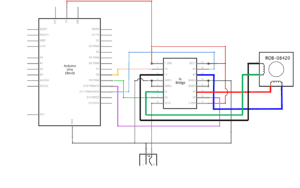
– Process:
Initially, I put the H bridge upside down. I didn’t realize that until someone reminded me. After that, I finished the circuit very quickly without encountering any problems. I didn’t know why direction matters at that time.
Due to the time limit, I just followed the schematic without paying much attention to how they really work together. But I did some research to learn more about the working mechanism behind those components. For example, I found that there are four switches inside the H bridge. Two of them are opened while the other two are closed. A while later it changes another way round so that it can constantly change the polarity of the motor.
After I finished the first two steps, I worked with Cathy. She also finished the individual part. Together we fixed the stepper motors, put the coupling on top of them, and connected the arms with the paper fastener. Generally, the motor reacts well as expected despite a little bit of delay. Given that the arms and pen are unstable, and there’s a lack of accurate calculation, we could only expect a random drawing. And I’m willing to explore how to do that in the future.
Here’s my work:
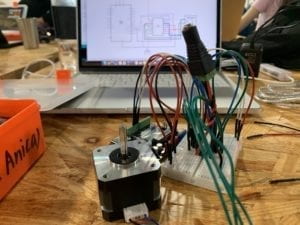
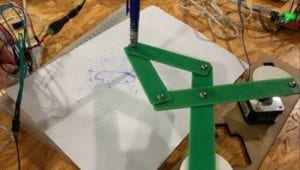
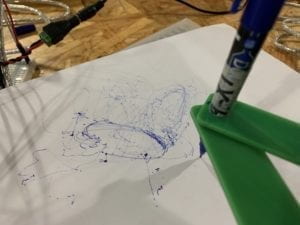
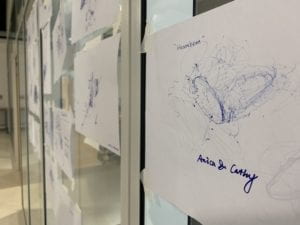
Video: Motor works
Video: Control the motor
Video: Drawing Process
Answers to questions:
Question 1: What kind of machines would you be interested in building? Add a reflection about the use of actuators, the digital manipulation of art, and the creative process to your blog post.
I would like to build a tree-planting machine for decoration. Basically, there’s a flower pot covered with color sensors and distance sensors, and there’s also a tiny projector behind. Whenever people come close it will detect them and begin to work. Then people put their hands on the side so that the “plant” began to grow, the image of which will be projected on the wall. By moving their fingers around the side in different directions it can adjust the growing speed. Without the human touch, it can also change colors of the image of the plants according to the environment light/colors(eg. the brightness of your room, the color of your outfit. People like to put the plants in their homes for decoration. But in modern life, they don’t necessarily have time to care about them. Considering the limited space, it’s even unlikely to put trees inside. But with this digital manipulation of art, the house can be decorated well. Since the machine won’t start unless humans get close, people feel engaged in this conversation.
Question 2: Choose an art installation mentioned in the reading ART + Science NOW, Stephen Wilson (Kinetics chapter). Post your thoughts about it and make a comparison with the work you did during this recitation. How do you think that the artist selected those specific actuators for his project?
The Firebird created by Paul DeMarinis, 2005, left a deep impression on me. It can change instantaneously the temperature of the air around the flame, so the air vibrates and generates the sound continuously. The sound is used to create the political speech of historical people like Starlin and Hitler. Since it’s a little-known technology discovered in the early twentieth century, I’m really curious about how it really works. However, the idea that combining the seemingly relevant mechanics such as connecting temperature and sound is intriguing. On the other hand, this project is not only about making the sound but about representing political speech. I assume that the vibration of air may be rough and strong, making the voice cold, powerful and solemn.
Comparing with our drawing machine, I think firstly their project contains not only circuits but physical theories in the micro-world. Secondly, it provokes thoughts on the impact brought by those historic people. But both our work can be controlled by ourselves. For example, the unregulated sound can be customized to the regular tone of human beings. Similarly, by rotating the potentiometer we can control the arm and create our own drawing.
I think the artist selected those specific actuators because there’s an insight into the relationship between the physical world and the natural language of human society, and how natural language can be possibly created by a machine.